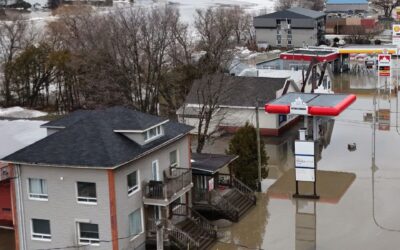They say a rising tide lifts all boats, but Canadian investors would do well to recognize that most assets don’t respond nearly as well to rising waters. The consequences of a warmer and more volatile climate have yet to be priced into markets, which could leave many Canadians under water, both physically and financially.
Climate impacts are the macroeconomic threat we’re not paying enough attention to. Disruption from climate-change-fuelled events is already hurting productivity, mobility, trade, communications, and food and water security, hurting economic growth and the health and well-being of people across Canada.
But beyond these acute crises, the impacts of living in a country that is warming twice as fast as the rest of the world carries a serious financial risk that threatens Canadian investors. The hard truth is we’ve been building, and investing, for a world that no longer exists, and the new world we need to rapidly start adjusting to is only now coming into view.
A new report from the Canadian Climate Institute on the costs of climate change for Canada’s infrastructure estimates that within 30 years, the cost of damage from coastal and inland floods to homes and buildings will increase to $4.5 billion to $5.5 billion annually—three to four times today’s rates. As spectacular flooding like we saw in Germany this summer becomes increasingly likely everywhere, the expensive housing stock of Toronto, Ottawa, Calgary, Edmonton, and Vancouver are among the assets most at risk.
However, owners of infrastructure—from homes to roads to electricity grids—have to rely on guesswork to assess the present and future risk of flood, wildfire, and permafrost because publicly available information is dated, inaccessible, or altogether absent. Banks, pensions, insurers and other institutional investors can use their considerable resources to assess such risks internally or pay others to do so, but without a strong foundation of open-access climate risk information, those assessments still leave gaps in financial analysis. So, not only do homeowners and business owners have less understanding of their climate risk than their lenders and investors, but nobody understands the entire scope of risk.
Without better information, building, buying, and investing in infrastructure that is vulnerable to climate change will continue, further exacerbating financial risk. Increased climate-related damage in vulnerable regions and industries will lead to higher costs of capital and insurance, which could eventually translate into reduced investment, higher levels of credit default, lower asset values, and lower returns.
To encourage investment in green and resilient infrastructure, one of best things governments could do is expand the availability of climate risk data that homeowners, government agencies, and financial services firms need to make financial decisions that align with a climate-smart future.
Gathering and publishing this climate risk data will require major new investments in modelling the current and future risks of flooding, wildfire, sea level rise, and other important climate hazards. And acting on this data will require ensuring that it is accessed and disclosed in financial transactions ranging from home purchases to major corporate and government issuances.
There is a strong incentive for infrastructure asset owners not to seek out or disclose climate risk, for fear that their asset will lose value or that their costs of insurance or capital will increase. For this reason, voluntary disclosure of risk isn’t enough: regulators need to step in by ensuring that climate risks are analyzed, disclosed, and priced into markets.
Disclosure is starting to happen but needs to accelerate: Canadian banks and pension funds are increasingly requiring climate risk reporting for their own portfolios but need to show leadership by supporting regulation that will accelerate uptake and innovation across the financial sector, as well as the creation of reliable, open-source risk information that will set a level playing field.
Without significant movement on climate risk information and disclosure, physical climate risks will continue to expand until some extreme weather event bursts the bubble. Individual portfolios will be affected, certainly, but the shock could ripple through Canada’s financial system, leaving Canadians under water, swamped by the pace of climate change. Will governments heed the warning and take the steps needed to shore up our defenses?
Originally published in The Toronto Star.








